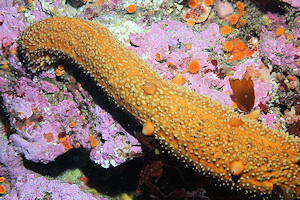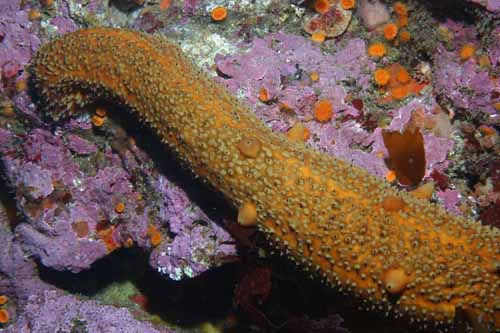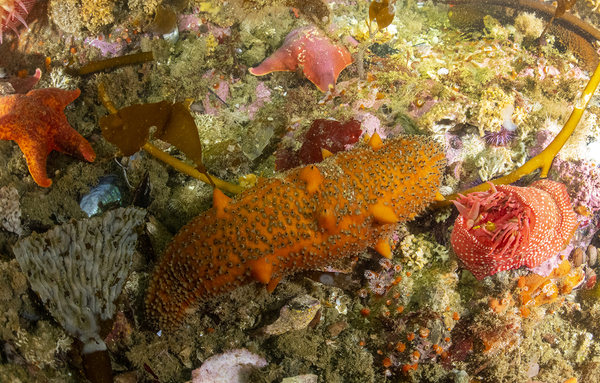
Warty sea cucumber
Apostichopus parvimensis
Overview
Key Features:
Body soft and elongated, with the axis running from mouth to anal end. Many small black-tipped papillae on dorsal surface; brownish in color.Similar Species:
California sea cucumber (Apostichopus californicus)Primary Common Name:
Warty sea cucumberSynonymous name(s):
Stichopus parvimensis, Parastichopus parvimensisGeneral Grouping:
Sea stars, urchins, cucumbers, sand dollars, brittle starsGeographic Range:
Monterey Bay to Baja California.
Monterey Bay to Punta San Bartolome (Baja California); uncommon and found only subtidally north of point Conception.Intertidal Height:
-2 to 0 feet (-0.6006006 to 0 meters)Notes:
Rarely encountered intertidally in central California.Subtidal Depth Range:
Minimum Depth: 0 meters or 0 feetMaximum Depth: 20 meters or 66.6 feet
Notes:
Can be common at some locations and virtually absent from others.Habitats:
bay (rocky shore), exposed rocky shore, kelp forest, protected rocky shoreNotes:
P. parvimensis is common on sandy or sandy-mud surfaces and between rocks, low intertidal zone of bays and well protected rocky shores; from the subtidal zone to at least 29 m, on rocks, pilings, sandy or mud bottoms, and, in tropical regions, in sea-grass beds.Abundance:
Relative Abundance:
Common on rocks at kelp forest depths in the Monterey region.Species Description:
General:
The Warty sea cucumber, Parastichopus parvimensis, has a cylindrical, highly contractile body, that can be black, brown, or red in color. The animals are covered above with elongate warts, and below with tube feet for locomotion and attachment to substrate. This imposes an almost bilaterally symmetrical pattern on these radially symmetrical animals. P. parvimensis is an epibenthic deposit-feeding holothurian. Members of the class holothuroiea are generally called sea cucumbers, though some of them bear no particular resemblance to the vegetable. Cucumbers may be flaccid when undisturbed, but when annoyed they become stiff and turgid, shorter in length, and thick. The body wall consists of a layer of circular muscles, connective tissue, and skin. The contraction of these circular and longitudinal muscle layers produces a wormlike or peristaltic action.Distinctive Features:
This species creeps more rapidly than most cucumbers (about 1 m in 15 min.). Holothuroids differ from echinoderms, because they have a water vascular system full of body fluid rather than sea water. When annoyed, P. parvimensis spews out its internal anatomy in a kind of autotomy, a trait that has protective values. Within two to four weeks the viscera will regenerate. In the usual evisceration, the hindgut just inside the anus is ruptured by the pressure of water caused by a sudden contraction of body-wall muscles. This contraction voids first the respiratory trees and subsequently the remainder of the internal organs. The water-vascular system characteristic of echinoderms is manifest in the cucumbers tube feet used for locomotion and feeding. The tentacles around the mouth are actually modified tube feet. Like other echinoderms, cucumbers have a calcareous skeleton; but in their case it is only vestigial, composed of plates and spicules of lime buried in the skin and serving merely to stiffen the body wall.Size:
Length: up to 46 cm (18 in.)<BR> Width: about 5 cm (2 in.)Natural History:
General:
Cucumbers in general have a specialized form of respiration that is unique among the echinoderms. Water is pumped in and out of the anus, distending two great water lungs (respiratory trees) that extend almost the full length of the body. This hollow space attracts commensals and parasites. The respiratory tree is the common home of two microscopic, one-celled animals, Lichnophora macfarlandi and Boveria sub-cylindrica, each of which clings by means of a ciliated sucking disk at the end of the posterior fleshy stalk. A pea crab may also be found near the posterior end of P. par-vimensis. The scale worm arctonoe pulchra, distinguishable by the dark spot on each scale, often lives commensally on the cucumbers body, along with the crab. Cucumbers will actually grow smaller if they don�t find sufficient food.Respiratory trees are the lungs of a sea cucumber. These hollow branched organs lie inside the body cavity on either side of the posterior intestine. The base of the tree connects to a muscular cavity, or cloaca. Circular muscles, or sphincters, close each end of the cloaca. A sea cucumber breathes by expanding the cloaca to draw oxygenated water in through the anus. The posterior sphincter then closes, then cloacal muscles contract to force water up into the respiratory trees. Oxygen is transferred across the thin membrane into the fluids of the body cavity. When the oxygen is depleted, the main body wall contracts to squeeze water out of the trees.
The calcareous ring is one of the few obvious, internal hard parts of a sea cucumber. It is comprised of a series of plates, usually 10, joined at the sides like a collar around the esophagus. The tentacle retractor muscles attach to this structure. The plates vary in shape in different species, so the shape of the ring is important in the classification of sea cucumbers. Being one of the few hard structures in a sea cucumber, the calcareous ring is often the only part that fossilizes, thus providing a way of relating extinct and living forms. Warty sea cucumbers and their related species are often called the �earthworms of the sea,� since they cultivate the seafloor in a very similar manner as earthworms cultivate soil. In areas where overfishing has reduced populations of sea cucumbers, the seafloor hardens, therefore destroying habitat for other bottom-dwelling creatures. Members of the genus Stichopus also have an unusual defense mechanism, they can melt, becoming completely limp and eventually disintegrating all together if taken out of the water. If they are not too far gone, they have the ability to reverse the process and recover.
Predator(s):
Predators include sea stars such as Pycnopodia helianthoides, fish, gastropods, and crustaceans as well as humans.Prey:
The warty sea cucumber feeds on soft sediments, digesting the organic detritus and small organisms contained within.Feeding Behavior:
Deposit feederNotes:
Parastichopus parvimensis will lie half buried in the soft substratum, passing through the intestinal tract quantities of sand and mud from which their food is extracted. The feeding tentacles, being part of the water vascular system, are extended and retracted by hydraulic pressure. P. parvimensis has mop-like tentacles, which when pressed onto the substratum pick up particles and transfer them to the mouth. The digestive system processes the organic matter, and the bits of shell and sand particles pass through the gut.Seasonal Behavior
November - December
Reproduction:
Sea cucumbers have separate sexes, but the sex is often difficult to determine by examining only external features. Reproductive organs of a sea cucumber consist of one or two tufts of tubules in the forepart of the body cavity. They combine into a single duct leading to an external gonopore near the tentacles. Spawning takes place usually in November, and each female can produce many thousands of eggs. P. parvimensis uses an external broadcast spawning method, so fertilization is largely a matter of chance. Environmental cues, such as consecutive sunny days, a plankton bloom, or a certain temperature, can cause a large number of individuals to spawn simultaneously, therefore increasing the chances for successful fertilization. After fertilization takes place, a larva is formed that metamorphoses into a sea cucumber, after only a few weeks.October - November
Migration:
Evisceration occurs spontaneously (without human interference) on a seasonal basis in the field. Natural populations have been shown to eviscerate more frequently in November and October. It takes about two to four weeks the viscera to regenerate.Issues
Monterey Bay National Marine Sanctuary:
In California, commercial fisheries seek two species of sea cucumbers, warty and Cali-fornia, which are shipped to Asian markets both here and overseas. Commercial fisheries need permits to fish for sea cucumbers, but there are currently no restrictions on the num-ber of animals that can be caught. Many sea cucumber fisheries worldwide have collapsed as a result of overfishing. De-mand for sea cucumbers in Asian markets, where people value them as food and medi-cine, is large. To fill that void, people began fishing for sea cucumbers in waters near the Galapagos Islands, starting in 1988. Then in 2001, the Inter-institutional Management Authority agreed to regulations allowing resident fishermen to catch up to four million sea cucumbers every year, in established fishing zones near the islands.References
- Carlton, J.T. 2007.
The Light and Smith Manual, 4th edition
Intertidal Invertebrates from Central California to Oregon
University of California Press. 1001 p.
- Meinkoth, N.A. 1998. National Audubon Society Field Guide to North American Seashore Creatures. A.A. Knopf, New York, NY. 813 p.
- Morris, R.H., D.P Abbott, and E.C. Haderlie. 1980. Intertidal Invertebrates of California. Stanford University Press, Stanford, California. 690 p.
- Ricketts, E. F., J. Calvin, and J.W. Hedgpeth. 1985. Between Pacific tides. Stanford University Press, Stanford, CA. 652 p.
- WWW
Monterey Bay Aquarium. Online Field Guide, 2008.
http://www.mbayaq.org/efc/living_species/
Accessed [04/27/06]
Accessed 01/30/2009 for Pelagic Cormorant
Accessed 8/19/09 for Bryozoan
Accessed 7/31/09 for Spiny brittle star
Accessed 3/31/09 for Sunflower star
Accessed 8/9/09 for red octopus
Accessed 8/19/09 for Decorator crab
Accessed 7/31/09 for warty sea cucumber
Related Information
Photo Library
Click on an image below to view a larger version in the SIMoN Photo Library. You will also be able to view important information on each photo such as photographer, date, caption and more






